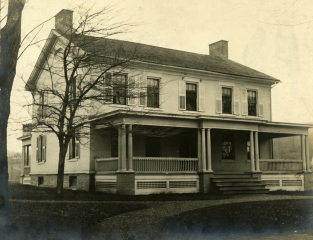of the English Department and coach. Despite the limited facilities of the Little Theater in the Administration Building and later in Lawrence Hall, Masque and Triangle, the dramatic society, staged some notable productions under his direction. The actual performances were usually given in the village “opera house” or movie theater.
Under the leadership of Professor Hoerrner and, after his retirement in 1934, Professor Thomas Roberts, the Glee Club received wide support and held to its customary high standards. Its quartet made the first commercial recording of Colgate songs in 1926 and in 1929 for the first time the Club gave a joint concert with a girls’ chorus, the Skidmore Glee Club. A smaller and more informal singing group, the Colgate Thirteen, was organized in July, 1942, “to spread Colgate spirit through song.” Beta Theta Pi inaugurated its annual intrafraternity song contest in the spring of 1930. The first of a series of student musical comedies was produced in 1935.
The highlight of the debating program was probably the team’s successful trip to English universities in 1924. Cambridge and Oxford teams visited the campus on their American trips. Able students and effective coaches-Carl A. Kallgren, ’17, Ralph E. Kharas, Lawrence A. Appley, and Jasper (Jack) V. Garland-combined to make excellent records.
The YMCA, renamed successively Colgate University Christian Union and Colgate Christian Association, played an active part in student religious life, especially under the sponsorship of Dr. Alton and Secretaries Shotts and Gregory. After the latter’s resignation in 1933 students with some faculty assistance took greater responsibilities. The Association arranged in 1936 for the first of the all-campus Mother’s Day weekend programs which Beta Theta Pi had inaugurated in 1933.
The two honorary senior societies, Skull and Scroll and Gorgon’s Head, in 1925 vainly attempted to merge as the Mercurius Society in an effort to eliminate campus politics in selecting members. Seven years later, however, they succeeded in consolidating as Konosioni which emphasized service to Colgate as well as recognition for athletic and other attainments. Acknowledgment of freshman and sophomore campus leaders came with the formation of the Maroon Key Club, a junior honorary society, in 1931.
Fraternity life was in its heyday in the 1920’s and ’30’s. Two were added to those already on campus-Theta Pi Delta, a local group





